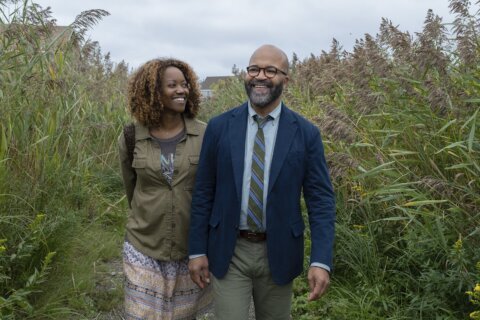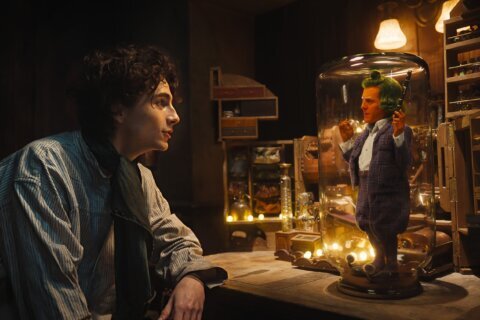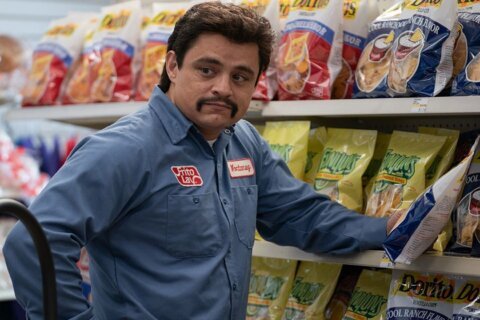Jason Fraley, WTOP Film Critic
WASHINGTON – Does the phrase “Kony 2012” ring a bell? The film, directed by Jason Russell for the non- profit group Invisible Children, is lighting up the internet with 46 million hits on YouTube, 533,000 “Likes” on Facebook and 48,000 followers on Twitter — all since being posted on Monday.
Many support it. Many criticize it. And many journalists have listed the pros and cons, including WTOP’s Meera Pal. But any film getting this much buzz can at the very least be called one thing — effective.
You can watch the video, research it and decide for yourself. My goal is to break down the techniques used by the filmmaker in what could very well be a template for the future of activist documentaries.
WARNING: The below video includes some disturbing images.
![]()
Act One
“Kony 2012” begins by making us feel on the cutting edge of world history. It opens with the quote:
“Nothing is more powerful than an idea whose time has come,” then changes those words to “whose time is now.”
Its first images are shots of Earth, followed by examples of our newfound interconnectedness, thanks to social media. The goal is to make viewers feel like we’re all in this together.
As the narrator says, “Right now there are more people on Facebook than there were on the planet 200 years ago … This connection is changing the way the world works. Governments are trying to keep up. And older generations are concerned.”
From here, Russell personalizes it, clicking around Facebook timelines to meet Jacob, a young boy from Uganda who watched his brother’s throat cut by the L.R.A., a group of Ugandan rebels led by Joseph Kony. Immediately, we feel like we’re watching some sort of a blend between “Hotel Rwanda” (2004) and “The Social Network” (2010).
Act One appeals to our emotions with powerful interviews, particularly that of Jacob crying as he describes what he would say to his brother if he were still alive: “I love you, but now I miss you.”
Russell then raises the stakes and defines his mission, saying to the audience, “If we succeed, we change the course of human history. But time is running out. This movie expires on December 31, 2012, and its only purpose is to stop the rebel group the L.R.A. and their leader Joseph Kony. I’m about to tell you exactly how we’re going to do it.”
It’s not until a full nine minutes in that we see the film’s title.
![]()
Act Two
The second act introduces us to Kony’s backstory through the eyes of Russell’s son, Gavin. He shows pictures to his son, describing the situation in clear terms of good guys and bad guys. “Joseph Kony has an army and what he does is he takes children from their parents and he gives them a gun and he makes them shoot and kill other people.”
If this were presented directly to the audience in sheer narration, it would sound ridiculous. However, by doing it through his son, he’s allowed to talk about the subject matter as simply as possible, ensuring we understand it.
Russell continues to play to our emotions (pathos) by showing slow-motion reenactments of adult hands pulling innocent children into the night, as well as a horrific montage of mutilated faces.
Narration describes Kony’s 26 years of kidnapping kids into the L.R.A., turning the girls into sex slaves and turning the boys into child soldiers, even forcing them to kill their own parents.
Here, the filmmaker employs the powerful technique of starting close on an object then pulling back to reveal its true size and scope. Here, it’s done digitally, starting with a row of children, then rising up above them to reveal a giant crowd, as the narrator says, “This is not just a few children. It’s been over 30,000 of them. And Jacob was one of those children.”
This technique was most powerfully done by Alain Resnais in the Holocaust documentary “Night and Fog” (1955), exposing mounds of Jewish hair at a concentration camp. It was also done effectively in “Gone with the Wind” (1939), revealing the countless bodies of confederate soldiers.
Perhaps the real hook of the documentary comes during the interview with Luis Moreno Ocampo, the head prosecutor for the International Criminal Court. As the camera pans across ICC documents, we see the many warlords on the court’s wanted list, including Libya’s Moammar Gadhafi at No. 24. In this way, Russell relates the issue to a notorious figure we all know — Gadhafi — right before revealing that Joseph Kony is No. 1 on the list! The document shows Kony was indicted on July 8, 2005 of crimes against humanity, including murders, rapes, sexual slavery and abductions.
Cleverly, the film then places a photo of Ocampo next to a photo of the filmmaker’s son — an expert and an innocent both agreeing that Kony should be stopped. These photos appear in color amidst a sea of black-and-white photos that ultimately form a giant globe. This image is layered with the narration: “It’s obvious that Kony should be stopped. The problem is 99 percent of the planet doesn’t know who he is.”
These black-and-white photos represent us as viewers, in the dark about this issue. Until now.
From here, Russell moves into the policy segment of the piece. He shows the filmmakers going to Congress to raise awareness and receiving pushback from both political parties. A colleague, John Prendergast of the Enough Project, concludes: “No administration — Republican, Democrat, Obama, Bush, Clinton, doesn’t matter — would do enough, because it’s simply not enough of an important issue on the radar screen of American foreign policy.”
So, the filmmakers kept up the pressure, until lawmakers of all political stripes began to support their cause. By including interviews with both Democrats and Republicans, the film tamps down perceptions of political bias, allowing Act Two to end on a triumphant note. On October 14, 2011, the group got the following letter:
“In furtherance of Congress’s stated policy, I have authorized a small number of U.S. forces to deploy to central Africa to provide assistance to regional forces that are working toward the removal of Joseph Kony from the battlefield. Sincerely, Barack Obama.”
Indeed, in October 2011, 100 American advisers were sent into Central Africa to assist the Ugandan government in arresting Kony and stopping the L.R.A. The narrator says, “It was the first time in history that the United States took that kind of action, because the people demanded it. Not for self defense, but because it was right.”
![]()
Act Three
Like most movies (fiction or documentary), “Kony 2012” ends Act Two with an “All is Lost” moment and launches Act Three with a new “race toward the finish.” At the 20:00 mark, we realize the trouble isn’t over with brooding music and an update from 12/2/11: “A 14-year-old boy who just escaped reports that ‘Joseph Kony now knows of the United States’ plan to stop the L.R.A. and he is going to change his tactics to avoid capture, now that the great power is after him.'”
The filmmaker shows that the “bad guy” has caught onto the fight against him, and that Act Three will be a call to keep up the pressure and not to allow the American advisers to leave. To do this, Russell again shows political balance, featuring an interview from “The Rachel Maddow Show” at one minute, then an interview with Senator Jim Inhofe (R-OK) the next. “It’s gotta be 2012,” Inhofe says, providing a deadline for Kony’s defeat.
To bring the film full circle, Russell brings back the historical backdrop and the attitude of “we’re all in this together.” He shows footage of Hitler and the Holocaust, saying, “It’s hard to look back on some parts of human history, because when we heard about injustice, we cared, but we didn’t know what to do. Too often, we did nothing. But if we’re going to change that, we have to start somewhere. So we’re staring here with Jospeh Kony, because now we know what to do. Here it is, ready?”
This allows the filmmaker to lay out his “cause and effect” marching orders:
- In order to arrest Kony this year, Uganda first has to find him.
- In order to find him, the Ugandans need the technology and training of U.S. advisers.
- In order for the advisers to do that, they need more support from the U.S. government.
- In order for more government support, the people need to show they care.
- In order for people to care, they need to know about it.
- In order for people to know about it, Kony’s name needs to be placed everywhere.
That’s the purpose of Russell’s documentary. He wants to make Kony famous, whether it’s sending out literature and bracelets, or targeting 12 policy makers and 20 culture makers (celebrities, athletes, billionaires). It’s all supposed to culminate on April 20 with a “Cover the Night” event, where activists plan to meet at sundown and blanket every street in every city with Kony posters.
Whether it works or not, the film’s idea of “turning the system upsidedown” resonates. As the ICC prosector says, “We are living in a new world, Facebook world, in which 750 million people share ideas, not thinking in borders.”
As Russell says, “Arresting Joseph Kony will prove that the world we live in has new rules, that the technology that has brought our planet together, is allowing us to respond to the problems of our friends.”
This is the promise of the internet and the power displayed already in the Arab Spring. Moreover, it’s redefining the notion of filmmaking and distribution, particularly for documentaries. No longer is a giant studio needed to churn out a movie. Now, one person with a digital camera can piece together his own film, upload it to YouTube, start a social network campaign, and change the world. Whether “Kony 2012” will do this remains to be seen. But its buzz speaks to something greater, that which director Francis Ford Coppola (“The Godfather”) envisioned decades ago:
![]()
Read more from WTOP Film Critic Jason Fraley by clicking “Fraley on Film” under the “Living” tab above, and check out his blog, The Film Spectrum.
(Copyright 2012 by WTOP. All Rights Reserved.)








